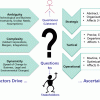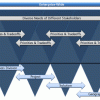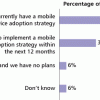Business Transformation Requires Transformational Leaders
Leadership and teaming skills are front and center in times of rapid change. Meet today’s constant disruption head on with expert guidance in leadership, business strategy, transformation, and innovation. Whether the disruption du jour is a digitally-driven upending of traditional business models, the pandemic-driven end to business as usual, or the change-driven challenge of staffing that meets your transformation plans—you’ll be prepared with cutting edge techniques and expert knowledge that enable strategic leadership.
Recently Published
In his book High-Risk Society, economist Michael Mandel wrote, "Over the long run, success will go to the people, companies, and countries willing and able to accept uncertainty.
The Art of Questioning
Business Architect vs. Business Analyst: What's the Difference?
In October and November 2012, Cutter Consortium conducted a survey that asked 69 end-user organizations worldwide about their use of mobile devices, including smartphones and tablets, in order to provide their employees and partners with the ability to interact with business operations, ranging from basic email to CRM and BI while "on the go." Our goal was to
When Robert Solow first said, in 1987, that "you can see the computer age everywhere but in the productivity statistics,"1 it highlighted a perennial problem: the disconnect between the investments made in IT and actual business benefits.













